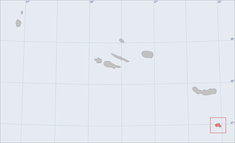Santa Maria Island
| Santa Maria | |
| Island (Ilha) | |
|
The arid coast of the western portion of the island of Santa Maria, location of the main settlement, Vila do Porto (as seen from Pico Alto)
|
|
| Official name: Ilha de Santa Maria | |
| Named for: Blessed Virgin Mary | |
| Nickname: Ilha Amarelo Claro (Light Yellow Island) | |
| Country | Portugal |
|---|---|
| Autonomous Region | Azores |
| Islands | Eastern Group |
| Location | Azores Platform, Mid-Atlantic Ridge, Atlantic Ocean |
| Municipalities | Vila do Porto |
| Civil Parishes | Almagreira, Santa Bárbara, Santo Espírito, São Pedro, Vila do Porto |
| Highest point | Pico Alto |
| - location | Facho-Pico Alto Volcanic Complex, Santa Bárbara, Vila do Porto |
| - elevation | 586.64 m (1,925 ft) |
| - coordinates | 36°58′58″N 25°5′27″W / 36.98278°N 25.09083°W |
| Lowest point | Sea level |
| - location | Atlantic Ocean |
| - elevation | 0 m (0 ft) |
| Length | 16.76 km (10 mi), Northwest-Southeast |
| Width | 10.29 km (6 mi), Southwest-Northeast |
| Area | 96.89 km2 (37 sq mi) |
| Population | 5,578 |
| Biomes | Temperate, Mediterranean |
| Geology | Alkali basalt, Tephra, Trachyte, Trachybasalt |
| Orogeny | Volcanism |
| Period | Holocene |
| Demonym | Mariense |
| Ethnic groups | Portuguese |
|
Location of the island of Santa Maria in the archipelago of the Azores
|
|
Santa Maria (Portuguese pronunciation: [ˈsɐ̃.tɐ mɐˈɾi.ɐ]), Portuguese for Saint Mary, is an island located in the eastern group of the Azores archipelago (south of the island of São Miguel) and the southernmost island in the Azores. The island is primarily known for its white sand beaches, distinctive chimneys, and dry warm weather.
The first records of a group of islands in the Atlantic (aside from the legends of Atlantis) came from the voyages of Portuguese sailors during the reigns of King Denis (1279–1325) and his successor King Afonso IV (1325–1357). These were unsubstantiated accounts and unofficial, until 1427 when navigator Diogo de Silves found the island of Santa Maria (at that time referred to on nautical charts as Ilha dos Lobos or Ilha do Ovo) during his journey to Madeira. Myth tells that on the day of the island's discovery, Gonçalo Velho Cabral and his crew were celebrating mass (on the feast day of the Virgin Mary), when one of the lookouts spotted the distant island, declaring "Santa Maria": this name would become linked permanently to the island. Santa Maria's discovery was attributed to Gonçalo Velho Cabral in 1432 (rather than the pilot Silves), since discoveries were not "recognized officially" until they declared so by the Portuguese Crown, who registered them in Cabral's name, as commander of the voyage (he had already commanded two voyages of exploration in 1431-1432).
According to legend Cabral's crew disembarked on a small beach in the northwestern Ponte dos Canestrantes, where he encountered a population of Eared seals, proclaiming the beach Praia dos Lobos (from the generic Portuguese lobos-marinhos, or monk seals ). The Captain and his crew explored the island, collecting various examples of the native and unfamiliar plants, as well as canisters of earth and water to give to the Infante as proofs to their discovery. The Infante received these "gifts" in 1432, and immediately ordered that herds be sent to the island, while he organized a plan for its colonization. In settling the Azores, the crown applied a system that was successful on the island of Madeira in 1425: the new lands would be administered by title grants (donatário) to a noblemen and men of confidence (donatary-captains) that would oversee security and colonization, while enforcing the King's law. The master or Donatário for the Azores was the Infante Henry the Navigator (in his role as governor of the Order of Christ and Duke of Viseu), who was granted to enforce the King's dominion (except to coin money and some judicial authority). The donatário also had the responsibility of selecting or sub-contracting local administrators to represent him, as some historians referred to as captains of the donatary; for his part, Gonçalo Velho, with the support of D. Isabella, was nominated the first captain of the island of Santa Maria and (later) São Miguel, where he arrived in 1439 with colonists, bringing their families and some cattle. By 1460, the chronicler Diogo Gomes de Sintra identified the island as Ilha de Gonçalo Velho, with the choicest lands in the hands of their commander.
...
Wikipedia


